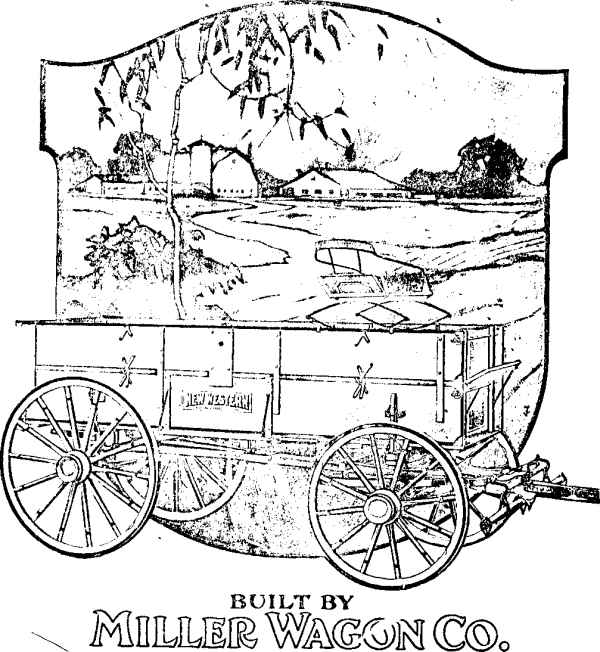
Calmar Wagon Factory 
MILLER, GIESING, MANCHESTER, HURLBUT, LUTZ, SCHULTZ, YAGER, CHVATAL, HAVEL, BERGE, HEYING
Posted By: Joy Moore (email)
Date: 8/28/2016 at 13:34:13
Source: Provided by Linus Cremer
HISTORY OF THE CALMAR WAGON FACTORY
In the year 1865, shortly after the close of the Civil War, a young blacksmith named Henry Miller, traveling westward from New York state in search of a place to locate and apply his trade, arrived in the village of Calmar. He rented an old building which stood on the site of the present Wagon Company Shop and engaged in the business of blacksmithing, horseshoeing, and general repair work.
Business became brisk and shortly afterward a brother, John Miller, a wagon maker by trade, joined him as a partner. Two years later John died and his place was taken by J. A. Giesing, an experienced blacksmith, machinist, and all around mechanic. The firm name was known as MILLER & GIESING AND COMPANY. It never became quite clear as to whom the term “company” referred to. However, there is a saying that there was a big burly Irishman, A. E. Manchester by name, who did seem to have some connection with the shop, although he never worked there, as he was a machinist in the Milwaukee Round House. It is said that it was him who invented the Three-Horse Evener which became very popular and was manufactured by the firm at a fine profit.
As business increased another wagon maker by the name of Hurlbut was hired by the firm, who served as a foreman until 1880. When he resigned he was replaced by Theodore Lutz, who held that position until 1917 when he resigned and moved to New York state. When Hurlbut took over, new machinery was installed and more man power was added. A giant lathe was also installed for turning steel shaftings to take care of the ever increasing business.
This became the red letter period for this company and more man and mechanical power was added again, so as to launch what later became a major enterprise, the manufacture of wagons and bob sleighs. A monster grindstone mounted in the street beside the shop on which the plows were ground and polished remained in its pace for many years, as a monument to the departed venture of manufacturing plows.
The manufacture of a complete wagon was an innovation in the Calmar community and this brightly painted vehicle with the lettering M*I*L*L*E*R grew to be known not only throughout Iowa, but Wisconsin, Minnesota, North and South Dakota, and Nebraska. The company’s largest order was for wagons for the U.S. Army. The annual output was over a 1000 wagons and sleighs a year.
Blacksmithing and repair work, its main business at first, now became a side line. It was necessary to add a salesman. C. H. Schultz was the first salesman, later succeeded by W. V. Yager who remained with the firm until 1917.
After a partnership of 21 years J. A. Giesing withdrew from the firm in 1882 and established a hardware business. After his withdrawal from the firm the business carried on under the name of Henry Miller Jr., until Mr. Miller withdrew from the complete ownership and management of the company in 1917. At this time the business was incorporated as Miller Wagon Company with a number of stockholders from Calmar and Winneshiek County.
However Mr. Miller served as president of the company until his death in 1920 He was born in Suchenheim, Germany on March 2, 1839, and came to America with his parents in 1842, settling in New York state and from there came to Calmar.
The business flourished for a number of years after his death and suddenly went into a decline and in July 1937, was offered for sale by the stockholders.
The business that was valued at approximately $50,000 was sold in 1937 to Anton Chvatal and John Havel for $3,000 and they successfully operated this factory, still making wagons and sleighs.
In 1947 the Berge Bros., Ray, Norman, and Otta, bought the old Calmar Wagon Factory. They specialized in the manufacture of truck platform, grain and stock bodies, all types of farm wagon boxes, and general repair. In 1959 the Berge’s remodeled the old factory putting in masonary walls, a new office, and a new roof on the half of the shop.
In 1972 the Berge Bros. sold out to John & Ernie Heying the current owner of the old Wagon Factory now known as HEYING MFG. CO. INC. which is now finishing the remodeling by putting on the other half of the shop roof.
The factory still manufactures pick-up racks, truck platforms, grain & stock racks and are producing up to 100 a year.
The printing plate of the advertising you see below was found in the debris while taking the old roof off, April 15, 1975.
Winneshiek Documents maintained by Jeff Getchell.
WebBBS 4.33 Genealogy Modification Package by WebJourneymen